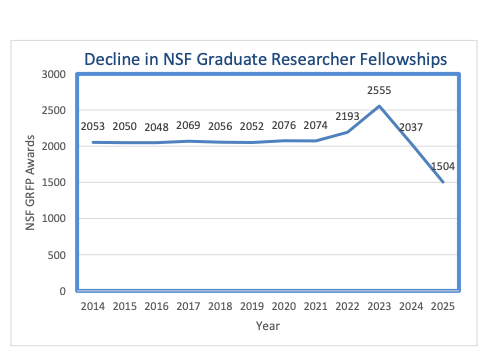At a time when competitor nations are already neck-and-neck with the United States, recent administration actions could destroy our global scientific leadership. Massive cuts to research funding and other administration policies are putting the longstanding partnership between U.S. universities and the federal government – a relationship central to America’s global leadership in science, technology, and the economic growth that comes from innovation – at serious risk.
Federal Research Cuts Hinder Innovation
Overall, the administration has proposed cutting federal funding for all research by 22% and basic research by 34% in the next fiscal year. This would effectively cede the race to China, whose research spending is expected to grow by 10% this year alone.
| Agency | FY25 | FY26 Proposed Budget | % Change |
| NIH | $46B | $27.9B | -39% |
| NSF | $8.826B* | $3.9B | -56%** |
| NASA – Science | $7.3342B | $3.9076B | -47% |
| DOE – Office of Science | $8.24B | $7.092B | -14% |
*OMB did not approve $234M of appropriated emergency spending for NSF, which is a reduction of 2.7%. Final FY25 funding is a reduction of 10.6% compared to FY23 (which included supplemental funding).
**The FY26 budget request would be a 61% cut compared to FY23.
This proposed budget slashing comes at a time when federal agencies are already significantly behind on awarding research grants compared to previous years, leaving potentially lifechanging discoveries to languish:
- NIH awards are down 29% and NSF awards have dropped 50% in 2025 compared to recent
- Some AAU institutions have reported 10-25% declines in federal research funding compared to 2024, with one university experiencing a 32%
Additionally, NIH, NSF, the Department of Defense, and the Department of Energy have proposed capping reimbursements to universities for costs related to performing federal research at 15%. These reimbursements fund essential infrastructure like lab operations, compliance, and data storage. The cap would seriously cut research capacity, leaving labs under-resourced and unable to perform critical research.
STEM Talent Pipeline at Risk
These cuts are also contributing to a brain drain that could cripple the STEM workforce and undermine America’s ability to compete globally.
Disruptions to the American research enterprise have created an opportunity for other countries – allies and competitors alike – to attract U.S. researchers, and they are seizing it:
- China is ramping up initiatives incentivize researchers to continue their work in China and is actively recruiting American scientists who have lost federal
- Canada, Australia, Europe, and other allies are also recruiting S.-based researchers.
Grant terminations, delayed or frozen obligations, and overall funding uncertainty are damaging the domestic STEM workforce pipeline:
- NSF has awarded hundreds fewer graduate researcher fellowships this year than last.
- Federal cuts are forcing universities to reduce the number of D. students they admit, damaging the broader STEM pipeline because graduate students work as teaching assistants and are relied on to run productive labs.\

Research Cuts Imperil Health, Economy, and National Security
For decades, federal investments in research have led to new cures, driven economic growth, and strengthened national security. Proposed funding cuts, grant terminations, and funding freezes put our economy, our quality of life, and our safety at risk.
The United States enjoys the most advanced healthcare system in the world due to federally funded research:
- NIH research contributes directly to treatments for all Americans; between 2010 and 2019, NIH- funded basic research contributed to all 356 new drugs approved by the
- China is investing heavily in areas like cancer research, where its share of published cancer research and new oncology trials has passed ours for the first
- Biomedical industry leaders have called proposed research cuts catastrophic for “the advancement of biomedical and biotechnology capabilities in the United ”
Research is the most important component of long-term economic growth:
- University research drives economic growth; AAU institutions were responsible for innovations that led to more than 600 startups and nearly 5,000 patents in 2022
- The economic benefits of federal research funding extend far beyond university campuses; federally funded university research supports more than 500,000 businesses across the country.
- The Institute for Macroeconomic and Policy Analysis at American University found that a 50% cut to research could decrease GDP by 7.6%, private investment by 8.6%, and tax revenue by 8.6%.
Since World War II, the government-university partnership has underpinned American military strength. Cuts to research make the U.S. less secure and put our troops in harm’s way:
- University research drives advances that give our troops the advantage on the battlefield and provide the basis of technologies like artificial intelligence, at the center of global
- As China makes massive investments in critical technologies with military and intelligence applications, cuts to federal research funding would undermine America’s innovation